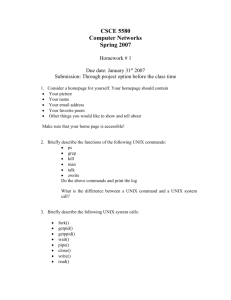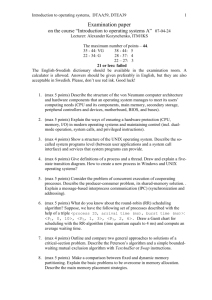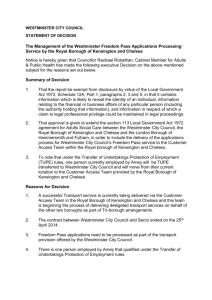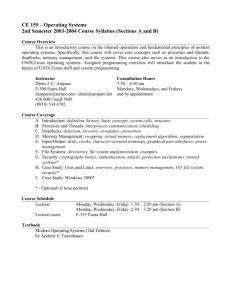Chelsea & Westminster Case Study
advertisement
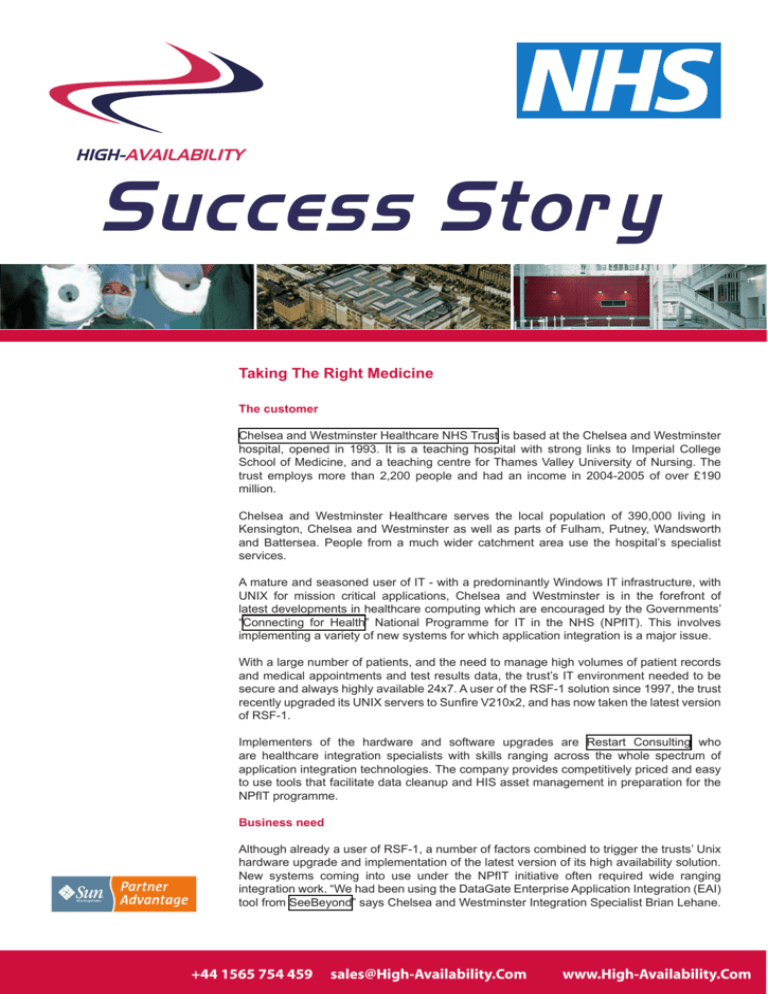
70: Success Stor y Taking The Right Medicine The customer Chelsea and Westminster Healthcare NHS Trust is based at the Chelsea and Westminster hospital, opened in 1993. It is a teaching hospital with strong links to Imperial College School of Medicine, and a teaching centre for Thames Valley University of Nursing. The trust employs more than 2,200 people and had an income in 2004-2005 of over £190 million. Chelsea and Westminster Healthcare serves the local population of 390,000 living in Kensington, Chelsea and Westminster as well as parts of Fulham, Putney, Wandsworth and Battersea. People from a much wider catchment area use the hospital’s specialist services. A mature and seasoned user of IT - with a predominantly Windows IT infrastructure, with UNIX for mission critical applications, Chelsea and Westminster is in the forefront of latest developments in healthcare computing which are encouraged by the Governments’ “Connecting for Health” National Programme for IT in the NHS (NPfIT). This involves implementing a variety of new systems for which application integration is a major issue. With a large number of patients, and the need to manage high volumes of patient records and medical appointments and test results data, the trust’s IT environment needed to be secure and always highly available 24x7. A user of the RSF-1 solution since 1997, the trust recently upgraded its UNIX servers to Sunfire V210x2, and has now taken the latest version of RSF-1. Implementers of the hardware and software upgrades are Restart Consulting who are healthcare integration specialists with skills ranging across the whole spectrum of application integration technologies. The company provides competitively priced and easy to use tools that facilitate data cleanup and HIS asset management in preparation for the NPfIT programme. Business need Although already a user of RSF-1, a number of factors combined to trigger the trusts’ Unix hardware upgrade and implementation of the latest version of its high availability solution. New systems coming into use under the NPfIT initiative often required wide ranging integration work. “We had been using the DataGate Enterprise Application Integration (EAI) tool from SeeBeyond” says Chelsea and Westminster Integration Specialist Brian Lehane. +44 1565 754 459 sales@High-Availability.Com www.High-Availability.Com “We now have an architecture that is more scalable, flexible and future-proof” Brian Lehane ReStart Consulting Delivering Health Care Solutions for the National Program for Technology in the NHS Another issue was the fact that laboratories handling the processing of medical tests were remote from the hospital and reliable communication of patient information was essential. “DataGate had been handling interfacing between our various different healthcare systems. For example LastWord patient admin system from IDX and two pathology systems from Cerner and Misys”. “In 2005, SeeBeyond withdrew support for DataGate, and support from Sun was also coming to an end for our then current Unix hardware. We called in Restart Consulting to handle the hardware and software upgrades – moving from DataGate to SeeBeyond’s ICAN (Integrated CorporateApplication Network).” “Our decision to initially install RSF-1 was driven by the increasingly obvious need to maintain round-the-clock availability for the growing number of applications and the respective interfaces. For example, the interface between LastWord and the Misys pathology system is used to pass HL7 messages between the two systems - including patient demographic details, orders for new tests and test results,” says Mr. Lehane. Previously, while there was switchability between the two former mirrored Unix machines, it was manual and monitoring of system status was fairly basic”. “We had a member of staff on call 24 hours a day,” says Mr Lehane. “If there was a failure, data would back up on any active host server and could be recovered. But there was no local data persistence. So our on-call person would have to come into the office, bring up the system, then the DataGate EAI and other interfaces, then the individual applications, one-by-one”. The solution “It took time, and there was always the nagging worry that there might be a problem contacting the on-call staff – or that switching systems in the event of a failure might raise issues that could not be immediately resolved. As the size and complexity of our IT operations grew, full 24x7 automatic failover was seen as essential and High-Availability.Com’s RSF-1 solution was adopted after comparing it with other competitive offerings”. “It was rugged, reliable, offered both manual and automatic failover modes, had an established user base and was a mature technology. Its price was also attractive. We also liked the simple, intuitive GUI interface, although, Unix enthusiasts can still stick to command line if they wish”. +44 1565 754 459 sales@High-Availability.Com www.High-Availability.Com “Previously ... it was manual and monitoring of system status was fairly basic” Brian Lehane 70: RSF-1 was originally released in 1995 and is designed to make services ‘highly available’ by switching between servers if a server or service fails. It provides multi-directional redundant ability that allows servers to constantly monitor and shadow each other. Rather than maintain a standby option idle as a failover server, RSF-1 allows operational systems to act as standby servers, ensuring that hardware investment is optimized. In the event of server failure, RSF-1 includes both Java and Windows based system admin modules that allow the cluster to be monitored and administered in real time – showing the status of any RSF-1 instances available on the network and provide manual switchover functions. High-Availability.Com designed and developed the first high availability solution for Sun Unix servers and has been leading the mission-critical market ever since with innovative products to help customers maximise their business IT and Internet functions. The company sells and supports products to customers throughout the world, ensuring critical applications and services keep running in the event of system failures. The benefits The two Sunfire V210s connect via a Shared Area Network. The ICAN software and Oracle database are on the SAN. In the event of a failure, RSF-1 closes down processes on the failed node, dismounts the primary node connection, reloads on secondary node and restarts – all automatically in just a minute or so. During this period incoming data persists in the SAN and when failover is complete, data for any unfulfilled transaction is simply rolled back. “Installation was relatively easy and painless. RSF-1 actually does what it says it’ll do. The bottom line is that we now have an automatic failover solution that works,” says Mr. Lehane. “We know that because since installing RSF-1 we have actually had a couple of failures. In each instance, the alternative Unix box was brought up virtually immediately with no loss of data”. “This inspires confidence in the resilience of our system and provides a solid platform for further expansion – much of which is driven by NPfIT initiatives. We now have an architecture that is more scalable, flexible and future-proof”. +44 1565 754 459 sales@High-Availability.Com www.High-Availability.Com
